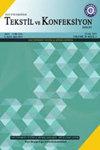牛仔织物磨损后摩擦系数及表面粗糙度的研究
IF 0.7
4区 工程技术
Q4 MATERIALS SCIENCE, TEXTILES
引用次数: 0
摘要
牛仔织物的耐磨性受织物表面性能(表面摩擦系数和粗糙度)的影响,这取决于织物的结构参数。研究了不同结构参数织造的牛仔布经磨损后的摩擦系数和表面粗糙度。总的来说,在初始磨损循环中,磨损过程降低了织物的摩擦系数,但随着磨损循环次数的增加,表面的摩擦系数增加。然而,由于磨损次数的增加,织物表面的粗糙度值稳步下降。牛仔织物是用3/1斜纹织物编织的。考察织物结构参数对织物摩擦系数和粗糙度值的影响时,纱线支数(Nm)、纱线密度与织物覆盖度呈负相关。织物的厚度、单位重量和容重呈正相关。本文章由计算机程序翻译,如有差异,请以英文原文为准。
Investigation of the Friction Coefficients and Surface Roughness Properties of Denim Fabrics after Abrasion
The abrasion behavior of denim fabrics could be affected by fabric surface properties (surface friction coefficient and roughness) depending on fabric structural parameters. This study investigated the friction coefficients and surface roughness properties of denim fabrics woven with different structural parameters after abrasion. In general, while the abrasion process reduced the fabric friction coefficients during the initial abrasion cycles, the surface's friction coefficient increased as the number of abrasion cycles increased. However, due to the increased abrasion cycles, there was a steady decline in the roughness values of the fabric surfaces. Denim fabrics were woven with a 3/1 twill weave pattern. When the effect of the fabric structural parameters on fabric friction coefficient and roughness values were evaluated, the yarn count (Nm), yarn density, and fabric cover factor showed negative correlation coefficients. In contrast, the thickness, unit weight, and bulk density of fabric showed positive correlation coefficients.
求助全文
通过发布文献求助,成功后即可免费获取论文全文。
去求助
来源期刊

Tekstil Ve Konfeksiyon
工程技术-材料科学:纺织
CiteScore
1.40
自引率
33.30%
发文量
41
审稿时长
>12 weeks
期刊介绍:
Tekstil ve Konfeksiyon, publishes papers on both fundamental and applied research in various branches of apparel and textile technology and allied areas such as production and properties of natural and synthetic fibers, yarns and fabrics, technical textiles, finishing applications, garment technology, analysis, testing, and quality control.
 求助内容:
求助内容: 应助结果提醒方式:
应助结果提醒方式:


